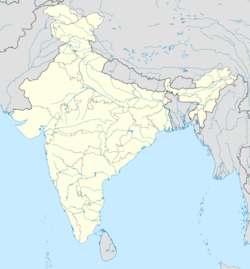world.wikisort.org - India
Assandh is a city and a municipal committee in Karnal district in the state of Haryana, India. Assandh is 45 km south-west of Karnal.
Assandh | |
|---|---|
City | |
 View of Assandh town from the Stupa | |
 Assandh Location in Haryana, India  Assandh Assandh (India) | |
| Coordinates: 29.51°N 76.72°E | |
| Country | |
| State | Haryana |
| District | Karnal |
| Population (2011)[1] | |
| • Total | 27,125 |
| Languages[2][3] | |
| • Official | Hindi |
| • Additional official | English, Punjabi |
| Time zone | UTC+5:30 (IST) |
| PIN | 132039 |
| ISO 3166 code | IN-HR |
| Vehicle registration | HR |
| Website | haryana |
| STD Code 01749, DL Code HR-40 | |
History
Early history
Archaeological excavations have revealed Painted Grey Ware,[4] associated with the Vedic people of Iron Age India. Assandh is identified with ancient Āsandīvat,[4][5] a capital of the Kuru Kingdom, which was the first recorded state in Ancient India, c. 1200 BCE.[6] Historian Charles Allen has related this town and the Stupa to the Asandhiwat Kingdom from which hailed Asandhimitra, the Chief Queen (Agramahisi) of the Mauryan emperor Ashoka.[7]
Assandh Stupa
The ruins of more-than-2000-year-old Buddhist stupa is situated at Assandh. The stupa is 25-metre high and at least 75 metres in diameter raised on an earthen platform. It is built with the help of bricks. This stupa is bigger than the much-famous stupa at Sanchi. According to historians, bricks used to construct this stupa, having a width of more than two-feet, indicate that the history of this monument dates back to more than 2000 years.
The ruins of this structure is also known as Jarasandh ka Qila/Teela or Jarasandh ka Teela (Fort/Mound of Jarasandh) named after a character of epic Mahabharat, and forms part of the 48 kos parikrama of Kurukshetra.[8]
According to Archaeological Survey of India, this is a Kushan stupa (belongs to Kushan period).[9]
Colonial era
Assandh had a large Muslims population before 1947. After the 1947, Muslims were replace with the Sikhs and Punjabi Khatri refugee migrants from Pakistani Punjab.
Modern history
Panipat was the part of District Karnal till 31 October 1989, which was upgraded as a separate District, including Assandh Tehsil of district Karnal. When the District was reformed on 1 January 1992 Assandh Tehsil was excluded from this District.
There is a Gurudwara, many Hindu Temples, a Sanatan Dharm Mandir and a Masjid also.
Demographics
As of 2011 Indian Census, Assandh had a total population of 27,125, of which 14,385 were males and 12,740 were females. Population within the age group of 0 to 6 years was 3,404. The total number of literates in Assandh was 18,192, which constituted 67.1% of the population with male literacy of 70.9% and female literacy of 62.7%. The effective literacy rate of 7+ population of Assandh was 76.7%, of which male literacy rate was 81.9% and female literacy rate was 70.9%. The Scheduled Castes population was 6,183. Assandh had 5081 households in 2011.[1]
As of 2001[update] India census, Assandh had a population of 22,707. Males constitute 53% of the population and females 47%. Assandh has an average literacy rate of 62%, higher than the national average of 59.5%; with 58% of the males and 42% of females literate. 15% of the population was in the 0 to 6 years age group.[10]
Politics
Assandh is part of Assandh constituency of the Haryana Vidhan Sabha. The following is the list of MLAs have been elected from this constituency:
- 1952 – Kasturi Lal – INC
- 1977 – Jogi Ram – JNP
- 1982 – Manphool Singh – LKD
- 1987 – Manphool Singh – LKD
- 1991 – Krishan Lal Panwar – JP
- 1996 – Krishan Lal Panwar – SAP
- 2000 – Krishan Lal Panwar – INLD
- 2005 – Raj Rani Poonam – INC
- 2009 – Pt. Zile Ram Sharma – INC
- 2014 – Sardar Bakhshish Singh Virk – BJP
- 2019 – Shamsher Singh Gogi – INC
Notable villages in Assandh Tehsil
- Gangatheri
- Jabhala
- Kheri Naru
- Uplana
- Rahara
- Rangrutti Khera
- Salwan
- Agond
References
- "Census of India: Assandh". www.censusindia.gov.in. Retrieved 9 October 2019.
- "Report of the Commissioner for linguistic minorities: 52nd report (July 2014 to June 2015)" (PDF). Commissioner for Linguistic Minorities, Ministry of Minority Affairs, Government of India. p. 24. Archived from the original (PDF) on 15 November 2016. Retrieved 25 June 2019.
- IANS (28 January 2010). "Haryana grants second language status to Punjabi". Hindustan Times. Retrieved 25 June 2019.
- Prāci-jyotī: Digest of Indological Studies. Kurukshetra University. 1967.
- Roshen Dalal (2010). Hinduism: An Alphabetical Guide. Penguin Books India. p. 177. ISBN 978-0-14-341421-6.
- M Witzel, Early Sanskritization: Origin and Development of the Kuru state, EJVS vol. 1 no. 4 (1995)
- Allen, Charles (2012). "16". Ashoka: The Search for India's Lost Emperor. Hachette UK. ISBN 978-1408703885.
- "Kurukshetra map". kurukshetra.nic.in. Archived from the original on 25 June 2016. Retrieved 24 July 2016.
- "List of Ancient Monuments and Archaeological Sites and Remains of Haryana - Archaeological Survey of India". Archived from the original on 26 October 2016. Retrieved 14 November 2017.
- "Census of India 2001: Data from the 2001 Census, including cities, villages and towns (Provisional)". Census Commission of India. Archived from the original on 16 June 2004. Retrieved 1 November 2008.
Другой контент может иметь иную лицензию. Перед использованием материалов сайта WikiSort.org внимательно изучите правила лицензирования конкретных элементов наполнения сайта.
WikiSort.org - проект по пересортировке и дополнению контента Википедии
